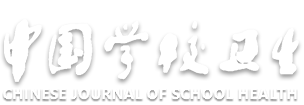Effect analysis of moderate intensity exercise prescription on the physical intervention of female college students
-
摘要:
目的 探讨中等强度运动处方对女大学生体质的影响,为通过高校体育教学提高女大学生体质健康管理提供参考。 方法 2019年9—12月在天津市河北工业大学随机抽取2019级两个女生班,以抽签法确定干预组和对照组,干预组45名,对照组42名。依据美国运动医学会推荐及干预组学生运动前测评结果,由体能教练设计中等强度运动处方,干预组实施16周、每周3次运动处方干预。干预组学生在每次锻炼后进行运动负荷的自我监测,体能教练每4周依据自我监测结果,对运动处方进行个性化调整。对照组不做运动处方干预。干预前后两组分别测定体质量指数(BMI)、肺活量、800 m跑和坐位体前屈,干预结束随机选取5名干预组学生进行访谈。 结果 干预后,干预组的BMI、肺活量、800 m跑和坐位体前屈结果分别为(20.41±1.45)kg/m2,(3 376.32±389.21)mL,(228.16±17.00)s,(15.63±4.36)cm;对照组分别为(22.60±2.38)kg/m2,(2 911.16±369.73)mL,(238.11±11.86)s,(15.47±7.45)cm;干预组肺活量、800 m跑和BMI与对照组间差异均有统计学意义(t值分别为-5.22,5.71,-3.15,P值均<0.05);干预组较干预前BMI降低2.69 kg/m2,肺活量增加537.64 mL、800 m跑成绩减少16.00 s。干预组干预前后肺活量、800 m跑和坐位体前屈的优良率差异均无统计学意义(χ2值分别为3.20,0.76,3.63,P值均>0.05)。经访谈,干预组学生认为运动处方提高了体质健康水平;干预过程中同学、教练的鼓励支持,教练的组织、监督指导对完成全程干预有很大帮助。 结论 规律、持续的中等强度运动处方能增进女大学生的体质健康水平;有关运动处方的健康教育、支持性环境及良好的干预活动组织可提高运动依从性及效果。 Abstract:Objective To explore the influence of moderate-intensity exercise prescription on the physical fitness of female college students, so as provide a reference for improving the physical health management of female college students through college PE education. Methods From September to December 2019, two female classes of grade 2019 were randomly selected from Hebei University of Technology in Tianjin as the research objects, with 45 students in the intervention group and 42 students in the control group. According to the American Academy of Sports Medicine's recommendation and the results of pre-exercise assessment for students in the intervention group, the physical fitness coach designed the moderate-intensity exercise prescription, and the exercise prescription intervention was carried out in the intervention group for three times a week for 16 weeks. The students in the intervention group self-monitered their exercise load after each exercise, and the physical fitness coach made individual adjustments to the exercise prescription every 4 weeks according to the self-monitoring results. Before and after the intervention, BMI, vital capacity, 800-meter running and sitting forward flexion were measured in the two groups respectively. At the end of the intervention, 5 students in the intervention group were randomly selected for interview. Results After the intervention, BMI, 800 m and sit forward in the intervention group were (20.41 ± 1.45)kg/m2, (3 376.32±389.21)mL, (228.16±17.00)s and (15.63±4.36)cm, respectively. The control group were (22.60 ± 2.38)kg/m2, (2 911.16±369.73)mL, (238.11±11.86)s, (15.47±7.45)cm respectively. The vital capacity, 800 m and BMI results of intervention group were better than those of the control group(t=-5.22, 5.71, -3.15, P < 0.05). Compared to those before intervention, in the intervention group, BMI was decreased by 2.69 kg/m2, while vital capacity and were improved by 537.64 mL, the time for 800 m was reduced by 16.00 s, respectively. However, there was no significant difference in the excellent rate of vital capacity, 800 m and sit forward before and after the intervention group(χ2=3.20, 0.76, 3.63, P>0.05). During the interview of the intervention group, the students believed that exercise prescription improved the physical health level; the encouragement and support of students and coaches, supervision and guidance of the coach were of great help to complete the whole intervention. Conclusion Regular and continuous moderate intensity exercise prescription can improve the physical health level of female college students; exercise prescription health education, supportive environment and good organization can improve exercise compliance and effect. -
Key words:
- Motor activity /
- Body constitution /
- Health promotion /
- Intervention studies /
- Students /
- Female
1) 利益冲突声明 所有作者声明无利益冲突。 -
世界卫生组织(WHO)体力活动简报显示,世界范围内约1/3女性体力活动不足[1];青春期女生比青春期男生更不活跃,85%的女生不符合WHO关于每天至少进行60 min中等至剧烈强度体力活动的建议。由于女性体育社会化程度远低于男性, 以及女性健身价值观念的偏差,使得女性健身运动习惯难以养成[2]。体力活动可以促进青少年生长发育,减少许多慢性病风险[3]。为有效提高我国学生体质健康,2016年中共中央、国务院印发的《“健康中国2030”规划纲要》[4]中明确提出“《国家学生体质健康标准》达标优秀率25%以上”;2021年8月3日,国务院印发的《全民健身计划(2021—2025年)》[5]提出“到2025年经常参加体育锻炼人数比例达38.5%”。第八次全国学生体质健康调研结果显示,虽然学生体质健康达标优良率总体呈上升趋势,但大学生体质健康达标优良率只增长0.2百分点[6]。大学生是国家的未来和希望,大学体育是大学生走上社会之前提高健康素养和形成良好运动习惯的关键一环。运动处方是通过有计划的经常性锻炼达到健身或预防疾病的目的[7],有规律的体力活动可以提高青少年心肺功能和健康水平[8-9]。本研究拟通过分析中等强度运动处方对女大学生体质的干预效果,探讨改善女大学生体质的有效方法,并为促进女大学生运动习惯养成提供线索。
1. 对象与方法
1.1 对象
采用整群随机抽样选取研究对象。以天津市河北工业大学2019级女生为研究对象,以体育教学班为单位,应用随机数字表法选取2个班后,采用抽签法确定干预组和对照组。其中干预组45名,平均年龄(19.2±0.7)岁;对照组42名,平均年龄(19.1±0.8)岁。为在锻炼干预中最大限度保证学生安全,对干预组学生进行运动前健康筛查[10],45名学生通过了运动前健康筛查。干预组45名学生全部完成16周运动处方干预。所有入组大学生对本次干预知情,自愿参加并积极配合,研究对象均签署知情同意书。本研究通过了河北工业大学科学技术研究院的伦理审批。
1.2 方法
本研究应用运动处方对女大学生体质进行干预。干预时间为2019年9—12月,共16周。对照组采用每周1次,每次90 min体育课,按照教学大纲进行的常规体育教学。干预组在常规体育教学的基础上,课外增加16周规律的运动处方干预,要求干预组学生尽可能参加本班课余时间的集体训练,每次运动后简单记录运动负荷自我监测,内容包括锻炼目的、锻炼时长、运动前后心率、运动前后训练反应等。体能教练每4周根据每个学生自我监测结果指导学生对有氧运动和力量训练的时间和强度进行调整,形成个性化锻炼方案;同时传授运动相关知识与技能。依据《国家学生体质健康标准(2014年修订)》[11],对87名研究对象的身高、体重、肺活量、800 m跑、坐位体前屈进行干预前后2次测试并计算体质量指数(BMI)、各指标优良率。为确保锻炼干预质量和规律运动,2名专业体能教练参与运动处方实施过程中的组织、指导和监督,体能教练由具有体育教学与训练经验,且对运动处方有实施经验的体育教师担任。体能教练依据学生运动前评测结果编制个性化运动处方,每周告知干预组学生各自的运动处方内容和运动地点,要求学生准时参加锻炼。
1.3 运动处方
在查阅文献的基础上[10, 12-14],依据美国运动医学学会推荐[10],运动处方由有氧运动处方和力量运动处方组成[8],目标心率控制在64%~76%最高心率[10, 15]。结合学生实际情况及运动前评测结果,设计了本次研究中使用的中等强度运动处方。
依据心率判断中等强度体力活动,依据循序渐进原则,在最初的4周,要求靶心率在40%~50%最高心率,即78~97次/min[16-17],每周增加5~10 min主要运动时间,依据学生自我监测结果逐步调整到有氧运动和力量训练的运动强度。心率测定通过学生佩戴运动手环或运动中自测心率,运动后记录在运动负荷自我监测表中,要求测量方法前后一致。运动处方按照“准备运动—拉伸运动—主要运动—放松运动”的顺序组成。准备活动:围绕田径场操场慢跑热身,后进行5 min的拉伸活动,以防锻炼创伤。有氧运动练习:(1)锻炼项目为采用慢跑、跳绳、健美操等;(2)运动强度为60%~65%最高心率;(3)锻炼时间为每周一、周三、周五17:30以后进行,每次锻炼40~50 min,若遇到特殊天气及学生月经期等,则适当调整。力量练习:(1)锻炼项目为仰卧起坐、立卧撑、蛙跳;(2)运动强度为最大心率的55%~60%;(3)锻炼时间为每周一、周三、周五每次有氧运动后,每次锻炼40 min以上,若遇到特殊天气及学生月经期等,则适当调整。放松练习:运动后进行5~8 min的放松练习,主要对肌肉群进行按摩放松。要求干预组学生:(1)在体能教练监督、指导下每周独自完成3次运动处方训练,每次80~90 min以上。(2)学生不得随意更改运动处方,应根据训练反应与体能教练沟通后进行调整。(3)被试学生在干预期间不再参加其他课外体育锻炼。(4)本次干预中,在国庆长假前,提前告知每位学生的运动处方,鼓励干预组坚持每周一、三、五尽可能按照运动处方进行锻炼并做好运动记录。如果没有运动条件,建议学生在室内或安全户外场地做健美操、全身拉伸运动、快走、慢跑等运动,同时坚持做好运动记录。
1.4 访谈
干预结束后,采用随机数字表法抽取5名干预组学生进行访谈。访谈提纲包括运动处方干预效果、运动处方依从性、运动干预后锻炼兴趣的改变、对运动处方的建议等。
1.5 统计学方法
数据采用SPSS 20.0进行统计分析,组间身体素质指标的比较采用独立样本t检验;干预前、后,组内身体素质指标比较采用配对样本t检验;依据《国家学生体质健康标准(2014年修订)》[11]对体质指标进行等级划分,计算出各指标的优良率(优秀),率的比较采用χ2检验。检验水准α=0.05。
2. 结果
2.1 干预前、后两组女大学生身体素质指标比较
干预前,两组学生的肺活量、800 m跑、坐位体前屈和BMI指标差异均无统计学意义(P值均>0.05)。干预后,两组学生间肺活量、800 m跑、BMI的差异均有统计学意义(P值均<0.05),干预组指标优于对照组;两组学生坐位体前屈结果的差异无统计学意义(P=0.90)。见表 1。
表 1 中等强度运动处方干预前后干预组与对照组女大学生身体素质指标比较(x±s)Table 1. Comparison of the constitution indicators between two groups before and after the intervention among coedna(x±s)干预前后 组别 人数 统计值 肺活量/mL 800 m跑/s 坐位体前屈/cm BMI/(kg·m-2) 干预前 干预组 45 2 838.68±355.70 244.16±22.10 15.16±5.34 23.10±2.30 对照组 42 2 876.42±444.72 242.84±10.81 15.10±5.15 23.40±1.03 t值 -0.44 0.35 0.05 -0.78 P值 0.66 0.73 0.96 0.44 干预后 干预组 45 3 376.32±389.21 228.16±17.00 15.63±4.36 20.41±1.45 对照组 42 2 911.16±369.73 238.11±11.86 15.47±7.45 22.60±2.38 t值 5.71 -3.15 0.12 -5.22 P值 < 0.01 < 0.01 0.90 < 0.01 2.2 两组女大学生身体素质指标干预前后变化
干预组经过16周的中等强度运动处方干预,学生肺活量、800 m跑、坐位体前屈、BMI分别改善537.64 mL,16.00 s,2.69 kg/m2,经配对t检验,肺活量、800 m跑和BMI指标干预前、后差异均有统计学意义(t值分别为12.14,-17.02,-4.26,P值均<0.05)。坐位体前屈干预前后差异无统计学意义(t=0.86, P=0.42)。对照组学生肺活量、800 m跑、坐位体前屈和BMI在干预前、后差异均无统计学意义(t值分别为0.54,-2.16,2.15,0.37,P值均>0.05)。
干预组肺活量、800 m跑、坐位体前屈指标的优良率在干预前(24.0%,11名;33.3%,15名;35.6%,16名)、后(42.2%,19名;42.2%,19名;55.6%,25名)差异均无统计学意义(χ2值分别为3.20,0.76,3.63,P值均>0.05)。
2.3 访谈结果
访谈结果显示,干预组5名学生均认为干预后体质水平有所提高,运动处方干预有收获。对于运动强度和时间,学生总体感受是开始觉得累和耽误时间,后来可忍受并逐渐能够坚持;对运动处方内容,建议增加更多的运动项目,让学生有更多选择,并能在体育老师指导下掌握这些运动项目的技巧,提高锻炼的兴趣及水平。对运动处方依从的原因探讨,4名学生认为最重要的是“有教练指导和同学做伴”。教练在干预前依据学生的运动前评测结果制订运动处方,更适合个体情况;干预过程中可随时和教练沟通,教练会根据个人情况进行提醒、指导、监督及鼓励,尤其在最初1~4周;通过本研究,学生对运动技巧及自我监测方法有所掌握。
3. 讨论
体力活动对体质和健康有益,常被作为预防和治疗心血管病、糖尿病的重要手段[4, 10]。1996年美国《关于体力活动与健康的报告》[15]强调,应将体力活动融入日常生活,成为生活的必要组成部分。但在我国大学生中普遍存在健康意识薄弱,对健康问题不够重视,锻炼缺乏自觉性等问题[12-13],2/3的女大学生没有体育锻炼行动,有锻炼行动并坚持下来的仅占2.36%[18],女大学生体质达标优秀率较低[19]。因此加强女大学生体育意识、体育情感的引导和培养,对其身心健康发展至关重要;女性健康状况和相关行为习惯、生活方式还会影响下一代的体质健康[2];同时促进大学生获取更多体育知识、体育服务技能也对全民健身计划[5]宣传与实施有重要意义。
尧娟等[20]研究发现,在我国运动处方教学研究日渐增加,对学生身心健康发展起到积极促进作用[21-24]。本研究参考美国运动医学学会[10]有氧运动和肌肉适能的推荐运动量,结合女大学生运动前评测结果,制订了中等强度运动处方。选取BMI、肺活量、800 m跑和坐位体前屈作为运动处方干预效果指标。BMI可反映身体成分的变化,坐位体前屈是反映身体柔韧性的重要指标[10],肺活量和800 m跑则是反映学生心肺耐力的常用指标[11]。另外依据美国运动医学学会有氧运动进阶速度[10],结合我国大学学期的时间,本研究的干预时间为16周。本研究中体能教练指导、督促女大学生从中低强度运动处方开始;通过3~4周形成规律锻炼后,根据训练反应指导学生逐渐加大至中等强度运动,然后继续完成12周稳定的中等强度运动训练。
本研究中经过16周中等强度运动处方干预,干预组女生肺活量、800 m跑及BMI结果分别改善537.64 mL,16.00 s,2.69 kg/m2。反映出持续中等强度的运动处方可以有效降低体脂,使BMI降低。由于中等强度运动处方锻炼内容主要由有氧耐力练习和力量练习内容组成,对学生心肺功能、耐力水平都有明显的提高作用。因此中等强度运动处方可以作为提高学生心肺功能等各项身体素质的主要教学补充。但干预组干预前、后的肺活量、800 m跑和坐位体前屈优良率差异并无统计学意义。提示16周中等强度运动的运动处方还不能使素质指标的优良等级发生变化,要达到“达标优秀率25%以上”的目标还需要进一步探索。
大学生普遍存在体力活动时间减少、大学体育课运动强度下降的现象[25-27]。本研究中,干预组学生经过16周、240 min/周中等强度运动干预,使得肺活量、800 m跑和BMI的结果有所提升,干预组学生所用的锻炼时间和运动强度远高于对照组依据2014年《高等学校体育工作基本标准》开展的90 min/周的常规体育课[28]。因此建议要适当增加大学生体力活动时间。然而本研究16周的运动处方干预低于美国运动医学学会推荐的5~9个月干预[10],可能使中等强度运动处方对体质的干预效果并未充分展现,适当延长干预时间可能会有更好的效果。
研究表明,仅提供运动处方的知识并不足以改变运动行为,运动依从性差,不能持续、有规律运动影响运动处方效果[29-32]。本研究中干预组女生全部完成16周运动处方干预,通过对干预组学生的访谈,探讨了影响运动处方干预效果的可能原因。首先有研究表明提高自我效能感对体育锻炼有积极影响[33-36]。本研究中个体运动处方从较低强度开始,使干预组学生对自身期望增高,在面对有挑战的锻炼任务时,有更高的坚持性和耐受性。其次,整个干预过程的有效管理也促进了干预组学生的运动依从性。在16周的干预过程中,学生BMI水平、疲劳恢复速度、健康水平、环境因素等都可能发生变化,本研究中教练定期通过检查每个学生自我监测结果,指导学生微调有氧运动和力量训练的时间和强度,形成个性化锻炼方案,也使学生能熟练实施运动处方。通过对学生的指导、运动知识传授,促进了个人行为的改变;班级整体运动氛围、教练的指导监督为干预组学生营造了支持性的社会环境;由于是整班参与干预,教练/研究者能够更好协调运动时间及场地,为干预组学生提供更好的物质环境。上述经验提示运动依从性、体力活动习惯的养成应该是多层次多因素共同作用的结果[37]。
综上所述,中等强度运动处方对改善女大学生体质水平、引导女大学生运动习惯养成、促进体育意识的培养和提高学生体质健康管理能力有积极意义;同时也能为女性承担体育健康代际传递和健康文化传播奠定基础。访谈学生人数较少是本次研究的不足,但通过运动处方干预与访谈的结合也给出一些启示,建议采用更有针对性的设计探讨影响女性运动处方干预效果的环境要素,为体力活动的开展提供有力的环境支撑。
-
表 1 中等强度运动处方干预前后干预组与对照组女大学生身体素质指标比较(x±s)
Table 1. Comparison of the constitution indicators between two groups before and after the intervention among coedna(x±s)
干预前后 组别 人数 统计值 肺活量/mL 800 m跑/s 坐位体前屈/cm BMI/(kg·m-2) 干预前 干预组 45 2 838.68±355.70 244.16±22.10 15.16±5.34 23.10±2.30 对照组 42 2 876.42±444.72 242.84±10.81 15.10±5.15 23.40±1.03 t值 -0.44 0.35 0.05 -0.78 P值 0.66 0.73 0.96 0.44 干预后 干预组 45 3 376.32±389.21 228.16±17.00 15.63±4.36 20.41±1.45 对照组 42 2 911.16±369.73 238.11±11.86 15.47±7.45 22.60±2.38 t值 5.71 -3.15 0.12 -5.22 P值 < 0.01 < 0.01 0.90 < 0.01 -
[1] WHO. Physical activity fact sheet[EB/OL]. (2021-10-12)[2021-12-27]. https://www.who.int/publications/i/item/who-hep-hpr-run-2021.2. 2016/10/25: 2021/11/21. [2] 熊欢. 我国女性运动健康促进策略与路径研究[J]. 体育学刊, 2021, 28(3): 55-62. https://www.cnki.com.cn/Article/CJFDTOTAL-TYXK202103009.htmXIONG H. The strategy and path of women's health promotion through physical activity[J]. J Phys Educ, 2021, 28(3): 55-62. (in Chinese) https://www.cnki.com.cn/Article/CJFDTOTAL-TYXK202103009.htm [3] PIERCY K L, TROIANO R P, BALLARD R M, et al. The physical activity guidelines for Americans[J]. JAMA, 2018, 320(19): 2020-2028. doi: 10.1001/jama.2018.14854 [4] 中共中央国务院印发《"健康中国2030"规划纲要》[J]. 中华人民共和国国务院公报, 2016(32): 5-20.The CPC Central Committee and the State Council issued the Outline of the "Healthy China 2030" Plan[J]. Gazette State Council PRC, 2016 (32): 5-20. (in Chinese) [5] 国务院关于印发全民健身计划(2021—2025年)的通知[J]. 中华人民共和国国务院公报, 2021(23): 19-22.Notice of the State Council on printing and distributing the National Fitness Plan (2021-2025)[J]. Gazette State Council PRC, 2021(23): 19-22. (in Chinese) [6] 教育部. 第八次全国学生体质与健康调研结果发布[J]. 中国学校卫生, 2021, 42(9): 1281-1282. doi: 10.16835/j.cnki.1000-9817.2021.09.001Ministry of Education of the PRC. Release report of the Eighth National Survey on Student Physical Fitness and Health[J]. Chin J Sch Health, 2021, 42 (9): 1281-1282. (in Chinese) doi: 10.16835/j.cnki.1000-9817.2021.09.001 [7] 林英. 运动处方在健康促进与教育领域的应用初探[J]. 海峡预防医学杂志, 2021, 27(5): 94-96. https://www.cnki.com.cn/Article/CJFDTOTAL-HXYF202105041.htmLIN Y. Application of exercise prescription in health promotion and education[J]. Strait J Prev Med, 2021, 27(5): 94-96. (in Chinese) https://www.cnki.com.cn/Article/CJFDTOTAL-HXYF202105041.htm [8] GARBER C E, BLISSMER B, DESCHENES M R, et al. American College of Sports Medicine position stand. Quantity and quality of exercise for developing and maintaining cardiorespiratory, musculoskeletal, and neuromotor fitness in apparently healthy adults: guidance for prescribing exercise[J]. Med Sci Sports Exerc, 2011, 43(7): 1334-1359. doi: 10.1249/MSS.0b013e318213fefb [9] STAMATAKIS E, GALE J, BAUMAN A, et al. Sitting time, physical activity, and risk of mortality inadults[J]. J Am Coll Cardiol, 2019, 73(16): 2062-2072. doi: 10.1016/j.jacc.2019.02.031 [10] American College of Sports Medicine. ACSM's guidelines for exercise testing and prescription[M]. 10th ed. Philadelphia(PA): Lippincott Williams & Wilkins, 2018: 28-221. [11] 教育部关于印发《国家学生体质健康标准(2014年修订)》的通知[J]. 体育教学, 2014, 34(9): 10-11.Notice of the Ministry of Education of the PRC on printing and distributing the National Physical Health Standards for Students (revised in 2014)[J]. Teach Phys Educ, 2014, 34(9): 10-11. (in Chinese) [12] 周雷, 黄滨. 学生体质评价及运动处方[M]. 北京: 北京体育大学出版社, 2009.ZHOU L, HUANG B. Evaluation of students' physique and exercise prescription[M]. Beijing: Beijing Sport University Press, 2009. (in Chinese) [13] 杨静宜, 徐峻华. 运动处方[M]. 北京: 高等教育出版社, 2005: 15-232.YANG J Y, XU J H. Exercise prescription[M]. Beijing: Higher Education Press, 2005: 15-232. (in Chinese) [14] JONAS S, PHILLIPS E M. ACSM's exercise is medicine: a physician's guide to exercise prescription[M]. Philadelphia(PA): Lippincott Williams & Wilkins, 2009: 19-51. [15] Physical Activity Guidelines Advisory Committee. Physical activity guidelines advisory committee report, 2008[M]. Washington, DC: U.S. Department of Health and Human Services, 2008: D-3. [16] TANAKA H, MONAHAN K D, SEALS D R. Age-predicted maximal heart rate revisited[J]. J Am Coll Cardiol, 2001, 37(1): 153-156. doi: 10.1016/S0735-1097(00)01054-8 [17] GELLISH R L, GOSLIN B R, OLSON R E, et al. Longitudinal modeling of the relationship between age and maximal heart rate[J]. Med Sci Sports Exerc, 2007, 39(5): 822-829. doi: 10.1097/mss.0b013e31803349c6 [18] 王世香, 丁孝民, 张崇林. 大学女生体育锻炼行为对体质健康的影响[J]. 体育世界(学术版), 2020(1): 167-168. https://www.cnki.com.cn/Article/CJFDTOTAL-TYSJ202001103.htmWANG S X, DING X M, ZHANG C L. Influence of physical exercise behavior on physical health of college girls[J]. Sports World(Scholarly), 2020(1): 167-168. (in Chinese) https://www.cnki.com.cn/Article/CJFDTOTAL-TYSJ202001103.htm [19] 刘静民, 张威, 马良. 首都女大学生体质健康现状特征研究[J]. 中华女子学院学报, 2020, 32(1): 123-128. https://www.cnki.com.cn/Article/CJFDTOTAL-ZNXY202001018.htmLIU J M, ZHANG W, MA L. A study of physical health of female college students in Beijing[J]. J Chin Women's Univ, 2020, 32(1): 123-128. (in Chinese) https://www.cnki.com.cn/Article/CJFDTOTAL-ZNXY202001018.htm [20] 尧娟, 陆国田. 基于定量和图谱的运动处方教学态势分析[J]. 青少年体育, 2022, 106(2): 99-102. https://www.cnki.com.cn/Article/CJFDTOTAL-QSTY202202029.htmYAO J, LU G T. Analysis of exercise prescription teaching situation based on quantitative and atlas[J]. Youth Sport, 2022, 106(2): 99-102. (in Chinese) https://www.cnki.com.cn/Article/CJFDTOTAL-QSTY202202029.htm [21] 邢聪. 学校体育课程"运动处方教学模式"的设计与构建[J]. 中国学校卫生, 2021, 42(9): 1288-1292. doi: 10.16835/j.cnki.1000-9817.2021.09.004XING C. Design and construction of exercise prescription teaching mode in school physical education curriculum[J]. Chin J Sch Health, 2021, 42 (9): 1288-1292. (in Chinese) doi: 10.16835/j.cnki.1000-9817.2021.09.004 [22] 郭亚琼. 运动处方教学模式在高校瑜伽教学中的应用分析[J]. 江西电力职业技术学院学报, 2021, 34(8): 36-37. https://www.cnki.com.cn/Article/CJFDTOTAL-DLZG202108017.htmGUO Y Q. Application analysis of exercise prescription teaching mode in yoga teaching in colleges and universities[J]. J Jiangxi Vocat Tech Coll Elect, 2021, 34 (8): 36-37. (in Chinese) https://www.cnki.com.cn/Article/CJFDTOTAL-DLZG202108017.htm [23] 刘雨情, 林敏. 运动处方教学在高校跆拳道公共体育选项课中的应用[C]. 南昌: 第三届"全民健身科学运动"学术交流大会, 2021.LIU Y Q, LIN M. Application of sports prescription teaching in public physical education elective course of taekwondo in colleges and universities[C]. Nanchang: 3th Academic Exchange Conference of "Scientific Sports for National Fitness", 2021. (in Chinese) [24] 夏秋冬, 郑拯. 大健康背景下16周体适能干预课程对大学生体质水平的影响研究[J]. 体育科技文献通报, 2021, 29(12): 44-48. https://www.cnki.com.cn/Article/CJFDTOTAL-SPOR202112014.htmXIA Q D, ZHENG Z. Research on the influence of the 16-week physical fitness intervention course on the physical fitness level of college students under the background of general health[J]. Bull Sport Sci Technol, 2021, 29 (12): 44-48. (in Chinese) https://www.cnki.com.cn/Article/CJFDTOTAL-SPOR202112014.htm [25] 张爱国. 浅析大学体育课程中运动强度降低的危害与对策[J]. 江西电力职业技术学院学报, 2019, 32(11): 65-66. https://www.cnki.com.cn/Article/CJFDTOTAL-DLZG201911032.htmZHANG A G. A brief analysis of the harm and countermeasures of sports intensity reduction in college physical education courses[J]. J Jiangxi Vocat Tech Coll Elect, 2019, 32(11): 65-66. (in Chinese) https://www.cnki.com.cn/Article/CJFDTOTAL-DLZG201911032.htm [26] 舒泉勇, 徐忠. 大学体育课程中运动强度降低的危害与对策[J]. 文体用品与科技, 2018, 12(12): 163-164. https://www.cnki.com.cn/Article/CJFDTOTAL-WTYP201812080.htmSHU Q Y, XU Z. Harm and countermeasures of sports intensity reduction in college physical education courses[J]. Sci Technol Stat Sport Goods, 2018, 12(12): 163-164. (in Chinese) https://www.cnki.com.cn/Article/CJFDTOTAL-WTYP201812080.htm [27] 宋晓芬, 崔丙刚, 徐忠. 对当前大学体育课运动强度的思考[J]. 体育科技, 2016, 37(5): 140-141. https://www.cnki.com.cn/Article/CJFDTOTAL-TYKJ201605061.htmSONG X F, CUI B G, XU Z. Thoughts on the current college students' exercise intensity in PE class[J]. Sport Sci Technol, 2016, 37(5): 140-141. (in Chinese) https://www.cnki.com.cn/Article/CJFDTOTAL-TYKJ201605061.htm [28] 教育部关于印发《高等学校体育工作基本标准》的通知[J]. 中国学校体育, 2014(8): 7-9.Notice of the Ministry of Education on printing and distributing the Basic Standards for Physical Education in Colleges and Universities[J]. Chin Sch Phys Educ, 2014(8): 7-9. (in Chinese) [29] 杨晓悦. 基于行为改变理论的个性化运动干预方案设计研究[D]. 合肥: 中国科学技术大学, 2019.YANG X Y. Study on the design of individualized exercise intervention program based on behavior change theory[D]. Hefei: University of Science and Technology of China, 2019. (in Chinese) [30] 姚婉. 基于健康管理的杭州市社区体育发展现状及对策研究[D]. 杭州: 杭州师范大学, 2018.YAO W. Based on the health management of Hangzhou City community sports development present situation and countermeasure research[D]. Hangzhou: Hangzhou Normal University, 2018. (in Chinese) [31] 付晓月. 可穿戴式设备指导科学运动与促进健康的可行性分析[D]. 北京: 北京体育大学, 2018.FU X Y. Feasibility analysis of wearable devices for guiding scientific movement and promoting health[D]. Beijing: Beijing Sport University, 2018. (in Chinese) [32] 孟舒娴, 沈冲. 体育运动对大学生身心健康的干预效果及影响因素分析[J]. 中国学校卫生, 2018, 39(7): 1026-1029. doi: 10.16835/j.cnki.1000-9817.2018.07.019MENG S X, SHEN C. Effect and associated factors of physical exercise on the physical and mental health among college students[J]. Chin J Sch Health, 2018, 39(7): 1026-1029. (in Chinese) doi: 10.16835/j.cnki.1000-9817.2018.07.019 [33] 潘雨晴, 吕墨涵, 史宇晖, 等. 北京市某大学学生中同伴支持对体育锻炼行为的影响[J]. 中国健康教育, 2021, 37(9): 825-828. https://www.cnki.com.cn/Article/CJFDTOTAL-ZGJK202109013.htmPAN Y Q, LYU M H, SHI Y H, et al. The influence of peer support on physical exercise among college students in Beijing[J]. Chin J Health Educ, 2021, 37(9): 825-828. (in Chinese) https://www.cnki.com.cn/Article/CJFDTOTAL-ZGJK202109013.htm [34] 刘进, 王冬慧, 王超, 等. 初中独生子女锻炼动机的影响因素研究[J]. 体育科技文献通报, 2021, 29(7): 57-58. https://www.cnki.com.cn/Article/CJFDTOTAL-SPOR202107020.htmLIU J, WANG D H, WANG C, et al. Study on the influencing factors of exercise motivation of junior middle school students from one child family[J]. Bull Sport Sci Technol, 2021, 29(7): 57-58. (in Chinese) https://www.cnki.com.cn/Article/CJFDTOTAL-SPOR202107020.htm [35] 张思, 刘晓丽. 大学生体育锻炼、自我效能感与社交焦虑的关系调查[J]. 新体育, 2021(14): 99-101. https://www.cnki.com.cn/Article/CJFDTOTAL-XTYI202114029.htmZHANG S, LIU X L. Research on the relationships among physical activity, self-efficacy and social anxiety[J]. New Sports, 2021(14): 99-101. (in Chinese) https://www.cnki.com.cn/Article/CJFDTOTAL-XTYI202114029.htm [36] KANDOLA A, ASHDOWN-FRANKS G, HENDRIKSE J, et al. Physical activity and depression: towards understanding the antidepressant mechanisms of physical activity[J]. Neurosci Biobehav Rev, 2019, 107(12): 525-539. [37] 韩金勇, 何佳莉. 大众身体活动促进策略的国际经验与启示: 基于社会生态模型分析框架[J]. 体育与科学, 2021, 42(6): 61-69. https://www.cnki.com.cn/Article/CJFDTOTAL-TYYK202106010.htmHAN J Y, HE J L. International experience and enlightenment of the promotion strategy of public physical activity: based on the analysis framework of the social ecological model[J]. J Sports Sci, 2021, 42(6): 61-69. (in Chinese) https://www.cnki.com.cn/Article/CJFDTOTAL-TYYK202106010.htm 期刊类型引用(2)
1. 焦永辉,孙甲平,王昊. 基于CiteSpace的我国近十年运动处方发展研究:动态、热点与趋势. 文体用品与科技. 2024(02): 37-39 .  百度学术
百度学术2. 陈文锋,梁松尚,唐敏强. 循环训练对肥胖青少年代谢综合征的影响. 中国学校卫生. 2024(06): 807-811 .  本站查看
本站查看其他类型引用(9)
-

 点击查看大图
点击查看大图
计量
- 文章访问数: 446
- HTML全文浏览量: 251
- PDF下载量: 39
- 被引次数: 11






 下载:
下载:
 下载:
下载: